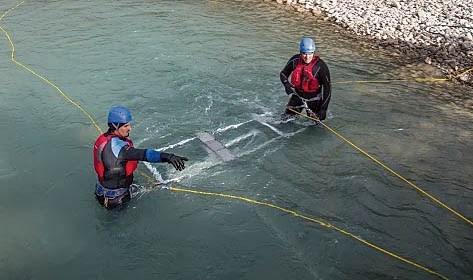River turbines will be used to generate electricity for some campgrounds currently without power in the mountain national parks.
Parks Canada is working with Quebec-based company, Idénergie, on the project, which will see about six turbines put into rivers or streams in Banff, Yoho, Kootenay, Glacier and Jasper national parks.
Officials say this green technology could power pay machines for campgrounds or lights in washrooms.
“We’ll have up to 10 turbines, but there will be more like six test sites for next year so we can keep some turbines in reserve in case there are any mechanical issues,” said Steve Blake, ski area and special projects manager for the mountain parks.
“At the end of the next summer we will own the equipment and it will be Parks Canada’s prerogative, if we’ve been successful, to determine the future applications of these turbines in Parks Canada.”
Idénergie’s spinning hydrokinetic river turbine has an embedded smart converter that allows conversion of the energy harnessed from the water current into electricity.
It can work in a water depth of 60 centimetres and can produce between four and 12 kWh daily.
Pierre Blanchet, Idénergie’s president and CEO, said their turbines are clean technology, providing a predictable and reliable source of energy 24 hours a day.
He said one river turbine can meet the electric needs of a small residence.
“As an example, you can expect a brand new 2015 refrigerator to consume 1kWh a day and this can produce between two and 12 kWh per day,” he said.
“It’s like with the wind turbine, the faster the fluid, the more energy you can extract. And compared to solar, it produces less energy but you’re going to have it day and night.”
Blake said Parks Canada’s idea is for the turbines to work in tandem with small solar systems that currently exist, or for sites that presently have no power at all.
He said it could power pay machines for campgrounds, a water filtration system that allows access to potable water, or lights in washrooms.
“This by no means would provide plug-ins for RVs,” said Blake.
“We don’t want to dramatically change the experience of camping that we have along a road like the Icefields Parkway, but we also recognize this is a new era.”
Bow Valley Naturalists say they are not necessarily opposed to the river turbines if this can replace generators.
“As always, the devil is in the details and we are guarded about the proposal until we know more about potential fisheries and associated impacts,” said Reg Bunyan, who sits on BVN’s board of directors.
Bunyan said Parks Canada runs numerous generators at its remote stations, campgrounds and abrasive storage areas, which for much of the year do nothing more than power a phone line, pumps or heavy equipment block heaters.
“These units often run 24 hours a day, 365 days of the year and the greenhouse gas emissions are collectively significant, relative to the power demand,” he said.
“If the intent is to decommission some of these units and replace them with river turbines, then that is a potentially positive step towards meeting our collective climate obligations,” he added.
“However, if the intent is to provide power at additional sites without decommissioning any of the existing generators, then let’s not kid ourselves: it may be nice from a visitor experience perspective, but let’s not pretend that it’s a new, green, climate change initiative.”
Before any turbines are put into rivers in spring, Blake said there would be a further assessment of the sites, including potential effects on the environment and on visitor experience.
“We looked at 22 sites throughout the mountain parks and I will now be reviewing a report that addresses the suitability of the stream in terms of power generation and proximity to a facility to use a bit of power,” he said.
“In general, they will go in in the spring of 2016, but some locations will depend on water levels and depend on fish spawning activities, so we may go earlier or later to try to influence spawning windows as little as possible.”
Blanchet said the company has taken into account several studies, including a fish passage study by Alden Laboratories in the United States.
He said fish tend to naturally avoid the turbine, resulting in a 90 per cent survival rate.
“I won’t say there was no impact. The mortality rate was below two per cent, but they found the fish are going around them,” said Blanchet.




